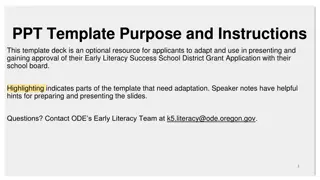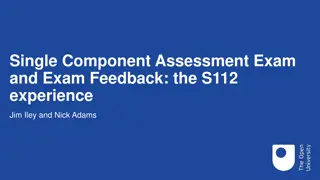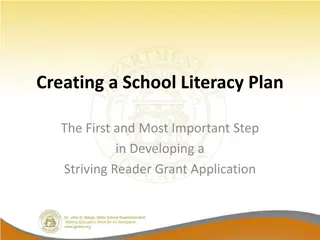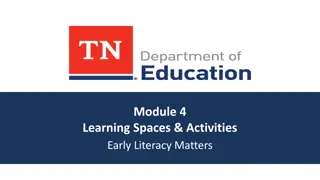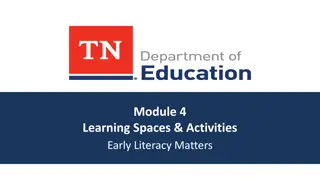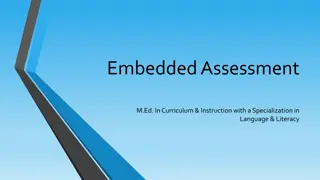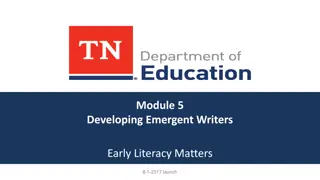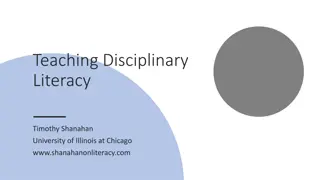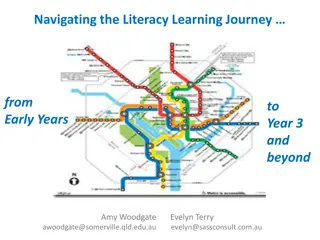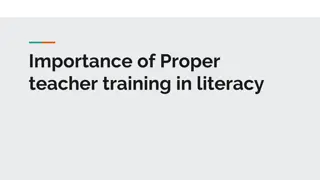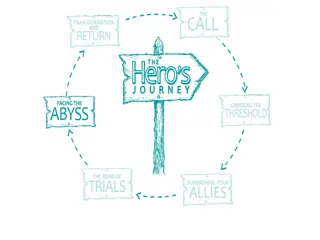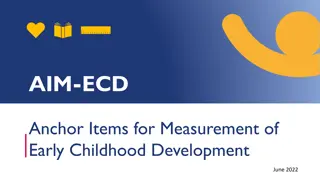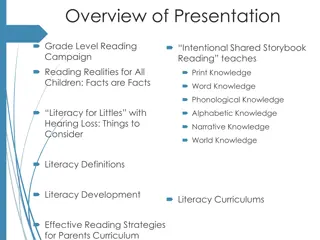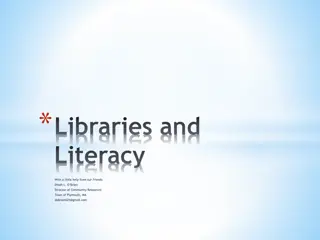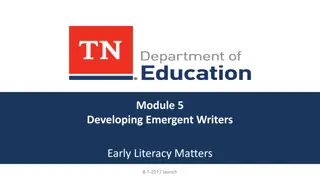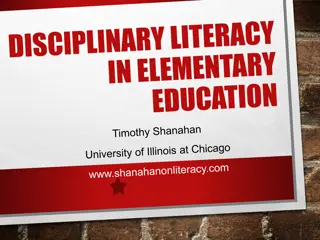Module 2: Literacy-Rich Environments and Experiences for Early Literacy Development
In Module 2, you will explore the importance of creating literacy-rich environments for young children to enhance language development. Reflect on positive interactions, intentional planning, and ways to engage children in meaningful literacy activities. Discover how classroom arrangements and materials can foster exploration and language use. Aligning with the Read to be Ready Campaign, this module emphasizes the critical role of teachers in promoting early literacy. Engage in instructional presentations and application activities to deepen your understanding and practice.
- Early literacy
- Literacy-rich environments
- Language development
- Read to be Ready Campaign
- Teaching strategies
Download Presentation

Please find below an Image/Link to download the presentation.
The content on the website is provided AS IS for your information and personal use only. It may not be sold, licensed, or shared on other websites without obtaining consent from the author. Download presentation by click this link. If you encounter any issues during the download, it is possible that the publisher has removed the file from their server.
E N D
Presentation Transcript
Module 2 Literacy-Rich Environments, Experiences, & Exchanges Early Literacy Matters 8-1-2017 launch
Module 2: Literacy-Rich Environments, Experiences, & Exchanges Module 2 at a glance In Module 1, you reflected on your own experiences with books and early literacy, and how those experiences impact the way you introduce early literacy activities and books to children today. Next, you will: Consider the ways the classroom s arrangement and selected materials can create opportunities for children birth to five to use language to explore, discover, experience, and make meaning of the world around them. Reflect on the ways positive teacher-child and child-to-child interactions help foster self- expression, rich conversations, and interest in books and writing. Learn how intentional planning is essential for creating literacy-rich environments, experiences, and exchanges to enhance language development for children birth to five years old. 2
Learner Outcomes for Module 2 Learner Outcomes: LO1: Learners will examine the ways classroom environments create opportunities for children to use language to explore, discover, experience, and make meaning of the world around them. LO2: Learners will describe the ways positive teacher-child and child-to-child interactions help foster self-expression, rich conversations, and interest in books and writing in the scenarios provided. LO3: Learners will explore ways to create literacy-rich wall displays that invite children to interact and build knowledge around a unit of study. 3
Connections to the Read to be Ready Campaign: This module aligns to the current Read to be Ready Campaign s following key beliefs: Early Literacy Matters: Teachers are critical: It takes a community: Video link to Early Literacy Matters from Read to be Ready Website: https://www.youtube.com/watch?v=60J8qRjRPkE 4
Module 2 Overview Overview: Module 2 will consist of 3 instructional presentations. These presentations will help you reflect on the special role a literacy-rich classroom environment plays in providing opportunities for children to interact with and learn from one another, teachers, and materials. In Presentation 1, you will analyze the ways classroom environments create opportunities for children to use language to explore, discover, experience, and make meaning of the world around them. In Presentation 2, you will examine the ways positive teacher-child and child-to- child interactions help foster self-expression, rich conversations, and interest in books and writing in the scenarios provided. In Presentation 3, you will explore ways to create literacy-rich displays that invite children to interact and build knowledge around a unit of study. Following each presentation, you will have the opportunity to apply your learning through Application Activities included in the Learning Guide. 5
Suggested Timeline for Completing Module Modules contain 4 short presentations that are designed to be completed during relaxed ratios or other times as set by your school or agency. Your director or program coordinator may suggest or establish a timeline for each presentation to be completed within the module. Please take a moment to confirm your site s requirements while noting the submission deadline for the final Learning Application Assignment that you will submit electronically to your literacy coach for feedback and support. All other completed activities will remain in your participation guide and available for your coaches review. Section 1: Start at beginning of module and complete Presentation 1 and Practice Activity 1. Section 2: Complete Presentation 2 and Practice Activity 2. Section 3: Complete Presentation 3 and Practice Activity 3. Section 4: Complete Learning Application Assignment for Module 2 and submit it electronically to your literacy coach for feedback and support. 6
Presentation 2: Literacy-Rich Teacher-Child Exchanges Video A Infants Watch Video A of Infants engaged in activity time play and use the chart in the Learning Guide to briefly respond to these questions: How did the teacher encourage or could have encouraged self-expression? How did the teacher encourage or could have encouraged rich conversations? How did the teacher encourage or could have encouraged interest in books and writing? https://www.youtube.com/watch?v=7DPhIQh91Mw 7
Teachers play a critical role Positive teacher-child exchanges or interactions: Promote rich conversations Use open-ended and guiding questions Increase vocabulary through modeling Create a love of literacy climate and interest in writing and reading materials. Keep these points in mind as you observe the critical role the teacher plays in the next Video B. 8
Video B teacher-child interactions First Viewing Watch the Video B of teacher-child interactions specific to the age group. Complete the answers to these questions on the comparison chart you added your reflection from Video A. How did the teacher encourage or could have encouraged self-expression? How did the teacher encourage or could have encouraged rich conversations? How did the teacher encourage or could have encouraged interest in books and writing? https://youtu.be/vm37vKnDdh8 9
Presentation 2: Literacy-Rich Teacher-Child Exchanges Video B Second Viewing Watch the Video B selection again that represents children you teach and use the chart in the Learning Guide to briefly respond to these questions: How was the teacher intentional in her interactions? What did she do and say? How did she interact? Was it a natural or forced approach to learning? How was learning embedded or intended? What concepts were modeled or taught? How did the teacher plan for the learning? How did the children respond? 10
Reflection of your own teacher-child interactions Now that you have had the opportunity to watch both video scenarios for a specific age group, reflect on your own teacher-child interactions when children are engaged in play or learning centers. Record your responses to each of the questions below in the Learning Guide: In what ways do you encourage conversations? How do you model use of new vocabulary? How do you promote children s interest in writing and reading? How do children respond to your interactions with them? 11
Practice Activity 2: Infants Plan Your Teacher-Child Interactions For this practice activity, you will intentionally plan your teacher-child interaction during activity play time to promote turn-taking and positive exchanges. Think of how you will set up the activity play time space to increase talk and provide opportunities for increased interactions between teachers and children. After interacting with the infant during activity play time, proceed to the next part of Practice Activity 2 to reflect on your planned teacher-child interactions. 12
Practice Activity 2: Plan Your Teacher-Child Interactions Reflection Questions Practice Activity 2: Reflect back on your planned teacher-child interactions during play episodes in which you intentionally modeled description words and reflect briefly respond to each of the questions below in the Learning Guide: How was planning ahead helpful? What would you do differently next time? How was your language intentional? How did the children respond? Did your model help to reinforce the meaning of the descriptive words? How did your interactions help to foster positive child-to-child interactions? 13
Completion of Section 2 of Module 2 Congratulations, you just completed Section 2 of Module 2. Check to be sure you completed all activities for Section 2 in the Learning Guide. Continue to intentionally plan for rich teacher-child interactions. You are now ready to begin Section 3. 14


